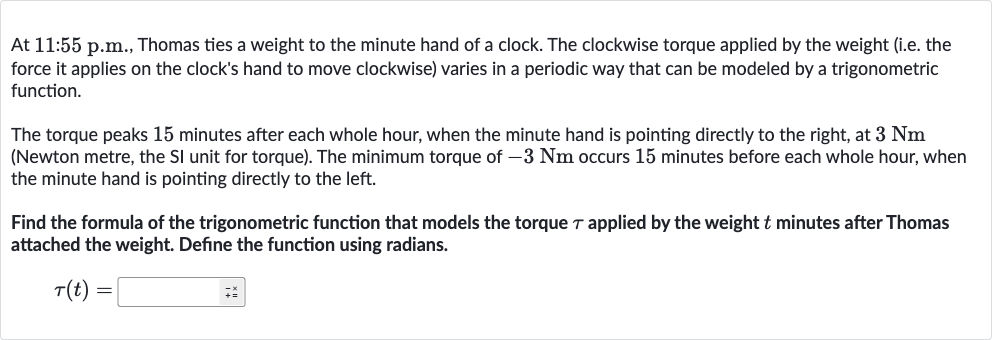AI tutor
Welcome to Bytelearn!
Let’s check out your problem:

At : p.m., Thomas ties a weight to the minute hand of a clock. The clockwise torque applied by the weight (i.e. the force it applies on the clock's hand to move clockwise) varies in a periodic way that can be modeled by a trigonometric function.The torque peaks minutes after each whole hour, when the minute hand is pointing directly to the right, at (Newton metre, the SI unit for torque). The minimum torque of occurs minutes before each whole hour, when the minute hand is pointing directly to the left.Find the formula of the trigonometric function that models the torque applied by the weight minutes after Thomas attached the weight. Define the function using radians.
Full solution
Q. At : p.m., Thomas ties a weight to the minute hand of a clock. The clockwise torque applied by the weight (i.e. the force it applies on the clock's hand to move clockwise) varies in a periodic way that can be modeled by a trigonometric function.The torque peaks minutes after each whole hour, when the minute hand is pointing directly to the right, at (Newton metre, the SI unit for torque). The minimum torque of occurs minutes before each whole hour, when the minute hand is pointing directly to the left.Find the formula of the trigonometric function that models the torque applied by the weight minutes after Thomas attached the weight. Define the function using radians.
- Identify Trigonometric Function: We need to find a trigonometric function that models the torque. The torque is at its maximum, , at minutes past the hour and at its minimum, , at minutes past the hour. This suggests a sine function because it has a period of minutes (one hour) and reaches its peak and trough at these times.
- General Form of Sine Function: The general form of a sine function is , where is the amplitude, is the frequency, is the phase shift, and is the vertical shift. The amplitude is half the distance between the maximum and minimum torque, so .
- Calculate Amplitude and Frequency: The period of the sine function is the time it takes for the torque to complete one cycle, which is minutes. The frequency is related to the period by . So .
- Determine Phase Shift: The torque peaks at minutes past the hour, which means the sine function should be at its maximum at . To achieve this, we need to shift the sine function to the right by minutes. Therefore, .
- Calculate Vertical Shift: The vertical shift is the average of the maximum and minimum torque, so .
- Final Sine Function: Putting it all together, the function is . However, we need to convert time from minutes to radians since the trigonometric function is defined using radians. There are radians in minutes, so radians = .
More problems from Identify discrete and continuous random variables
QuestionGet tutor help
QuestionGet tutor help
QuestionGet tutor help
QuestionGet tutor help
QuestionGet tutor help
QuestionGet tutor help
QuestionGet tutor help
QuestionGet tutor help
QuestionGet tutor help
